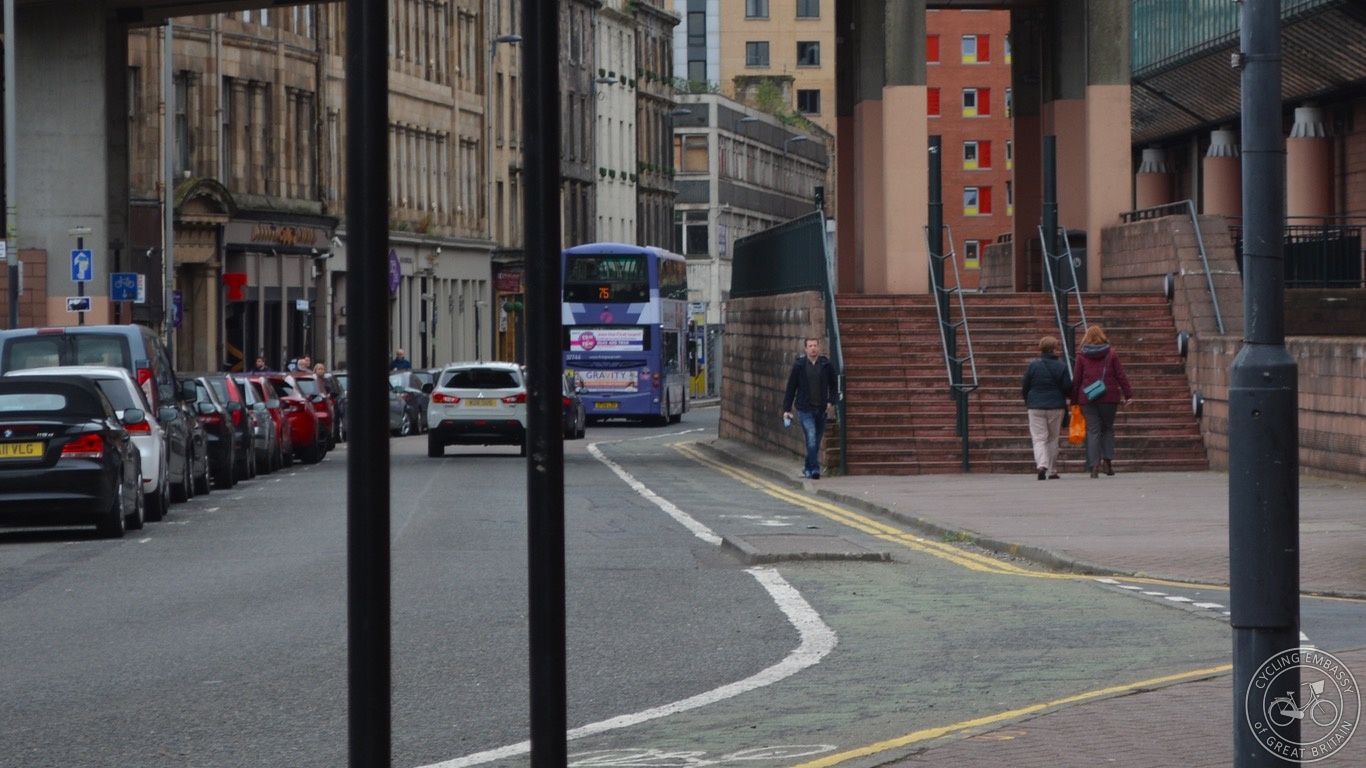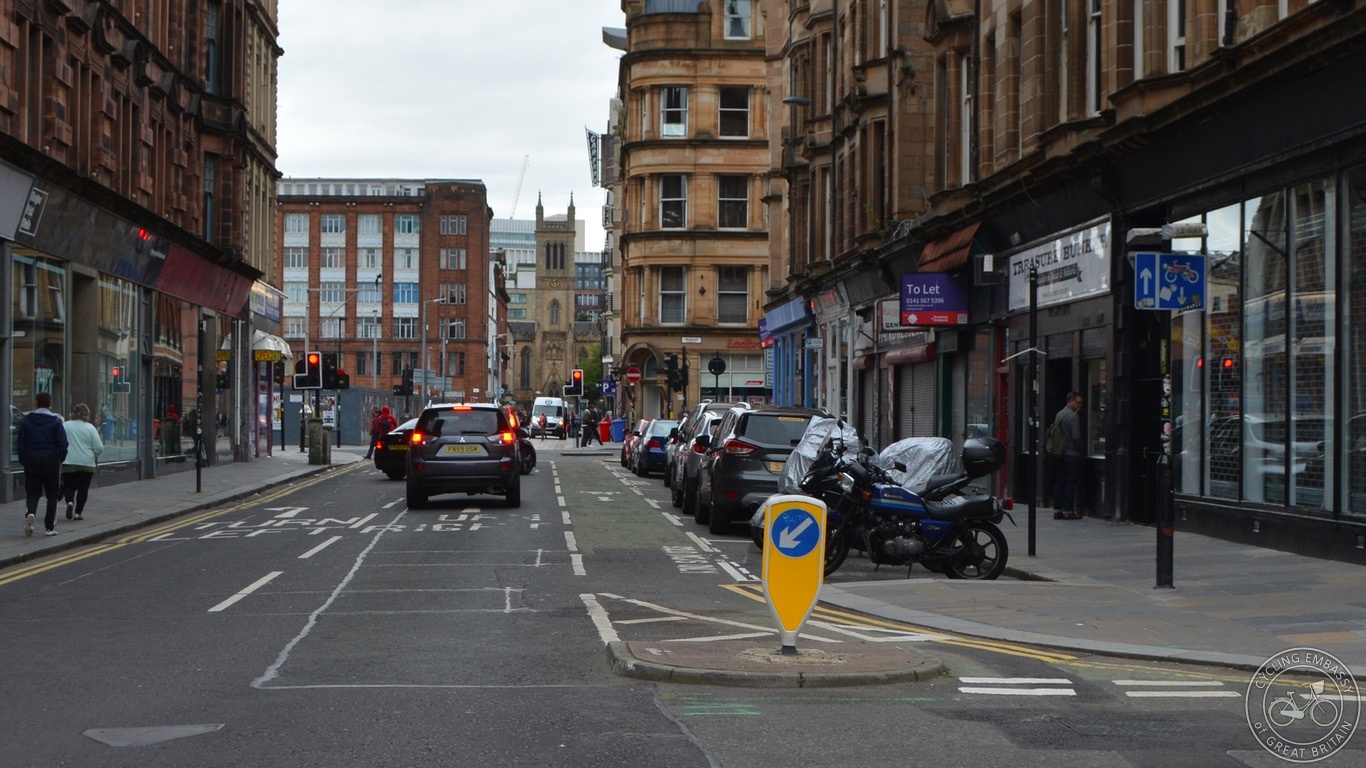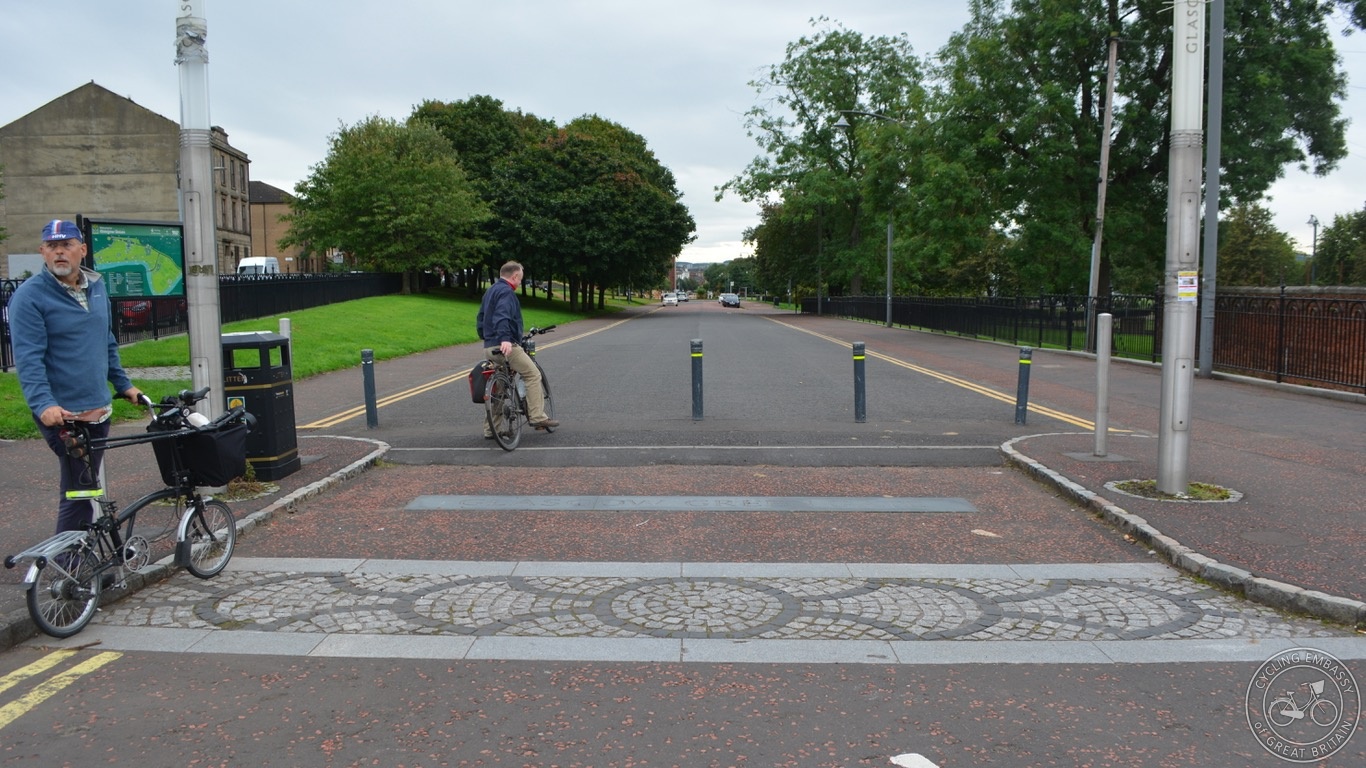A Glasgow excursion - the Cycling Embassy AGM's first infrastructure safari
The weekend before last, the Embassy descended on Glasgow for our AGM. As part of the weekend's events, we were escorted around the city for our traditional Infrastructure Safaris, kindly organised by GoBike. A big thanks to them!
Our first infrastructure safari - led by Andy Preece - started at the Glasgow Central station, and would take us on a potted tour of various parts of the city centre.
The city centre of Glasgow appears, at first sight, to be an area where people on foot greatly outnumbered all other modes of transport, yet the vast majority of space has been handed over to private motor traffic (and Glasgow doesn't even seem have a huge amount of bus lanes either).

Admittedly we were only visiting over the weekend, when motor traffic levels will naturally be lower, but it seems there's an awful lot of space that's going to waste, space that could be reallocated for walking and cycling without (much) political cost. Indeed, Glasgow has a bit of a golden opportunity to implement bold changes now before it hits the kinds of car-saturation problems affecting other UK towns and cities. More than half of all households in Glasgow do not have access to a car.
Once all the road space is clogged with cars, it naturally becomes a little harder to make the case for switching that space over to other modes, even if that remains the best way of tackling congestion. That reallocation is much easier if the roads are much emptier.
The other thing immediately noticeable about the city centre is that there are an awful lot of one-way streets. With the streets arranged on a grid pattern, it seems that almost every other street points in a different direction, which makes navigating by bike (especially when you've only just arrived in the city) very difficult indeed, and I ended up walking 'the wrong way' down some streets for a considerable part of my first trip, on Friday evening.
There are some contraflows, but they are intermittent, and you certainly can't rely on them. Nevertheless our trip away from the station did take us past one of these contraflows, with some attractive kerbing that maintained a smooth continuous footway for pedestrians, while still permitting motor vehicle access.

Of course it has to be said here that, in general, side road treatments for pedestrians in the city were pretty awful, and in many cases there weren't even dropped kerbs at all - so the above example, while good, was rare indeed.
Our route took as out of the city centre along another (painted) contraflow, one that, unfortunately, had intermittent bollard islands that created a gap that was only 80cm wide. Almost immediately the tape measures were out, slightly lightheartedly, but this is a serious point - this kind of infrastructure is definitely not #BeyondTheBicycle.

The other problem with this lane was that pedestrians, for quite sensible reasons, chose to walk in it, because the footway requires them to mount steps.

Not great design, all round, and certainly room (literally!) for improvement - this was an area of the city dominated by an expanse of surface car parking; amazing that so much valuable city-centre land could be taken up like this.

More contraflows followed - again, these are welcome (certainly much easier than trying to negotiate a one-way street system), but being sandwiched between car parking and oncoming motor traffic is not that attractive.

In an ideal world these contraflows would run between the car parking and the footway, for greater comfort and safety.
We were then onto our first 'proper' piece of protected cycleway, via a bit of filtering and a toucan crossing.

Walking and cycling could quite easily have been separated here; instead there is an awkward bit of cycling on the footway on the far side of the crossing, needed to access the cycleway.
The cycleway itself was bi-directional, and protected with a small-ish kerb. This is very similar to the kind of stuff that is now springing up in a number of cities across the UK - bi-directional cycleways reduce the complexity of signalling at junctions, making them a pretty obvious choice under current UK rules.

It's been executed reasonably well, although I think - given the road itself is one-way - it could easily have been a lot wider.
As is often the case with these well-meaning but slightly 'experimental' cycleways, however, it's at the junctions where things break down. A very odd, tight corner to take us into a cycleway on the opposite side of the road as we cross a junction made the junction itself excessively complicated.

Then, on a slightly busier road, the cycleway has a curious jutting out 'reservation' to allow people continue straight on down the road (because the bi-directional cycleway effectively forces people to turn the corner).

It's a bit of a mess, and shows how important it is not just to plan a 'route' from A to B, but to at least integrate cycleways into roads and streets over an area, rather than just a line on a map, and in turn to think more carefully about the kinds of movements people might be making.
This cycleway led us into Glasgow Green, a large park. The entrance is nicely filtered but was unfortunately built with a full-height kerb, which had to be hastily rectified with the addition of some tarmac, to create a steep-ish ramp.

This park was one of those that (notoriously) would have been subject to a proposed 5mph speed limit for cycling - which would have been totally ridiculous given the amount of space available, to say nothing of the difficulty of even staying below that kind of speed while cycling.
Our route then headed north through a residential area, along some relatively quiet streets where for some reason the 'cycle route' had been deposited on a shared-use footway.

That certainly didn't seem appropriate for this kind of area - residential streets should be quiet and safe enough to cycle on the carriageway, and with a large group like ours it certainly led to unnecessary conflict with people walking.
From this residential area we had to use some very wide and hostile roads to head up to Cathedral area. As with plenty of the roads we cycled around on in Glasgow, there's masses of space, and great potential to build meaningful infrastructure here.

Our route past the Cathedral took us to into a dead-end street, where a new dropped kerb allows access into a network of paths across the motorway to north of the city.

Unfortunately - while the dropped kerb is welcome - it hasn't been executed particularly well. It doesn't align with the path, and the dropped kerb itself was far from flush.

While we had some fun and games measuring just how high this 'dropped' kerb was, this is actually a serious issue - it can cause accidents if people cross it at the wrong angle, and can also make access by other types of cycles - cargo bikes, hand cycles, and so on - unnecessarily difficult, or impossible. So it's disappointing to see new infrastructure being built badly.
We then negotiated an enormous sprawling system of motorway-linked roads, on narrow bridges (shared with pedestrians) - a clear indication of the scale of car-centric development Glasgow has been subject to since the 1960s.

Our final stop on our first infrastructure safari was a path winding through a massive cleared area that is being redeveloped - Sighthill Park, separated from the city centre by the M8 motorway.

It remains to be seen how well this area will connect with the city - a new walking and cycling bridge is proposed across the motorway - and indeed how well cycling will be catered for within the redevelopment itself.
In the next post we'll report on the Second Infrastructure Safari, which took in more city-centre infrastructure, including the infamous motorway-spanning Bridge to Nowhere.

Comments
andy_gla
28 September, 2017 - 20:34
Permalink
Sighthill regeneration
Some information about the Sighthill regeneration here - https://www.glasgow.gov.uk/index.aspx?articleid=18395
Of particular interest will be the Sighthill Cycling Village attachment which shows where the cycle routes will go, and what they will consist of.
Leinster Wheeler
18 October, 2017 - 20:27
Permalink
Kerb at continuous footpath
The second photograph showed a contraflow adjacent to an entrance/junction with a continuous footpath. It caught my eye because the kerb looked something like the Dutch inritbanden (zip) kerb (only not as long). Do you know if this was a purpose made kerb or a flat slab put in at an angle? Was it a one off or can you find them in several places in Glasgow?
andy_gla
26 December, 2017 - 15:17
Permalink
There are a handful of other
There are a handful of other locations (such as at https://goo.gl/maps/5bnrHoSom482 ) where this style of kerb is used, so I guess it is available as a product, even if it is maybe only made to order. It has some quite nice end pieces too.